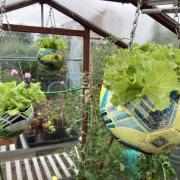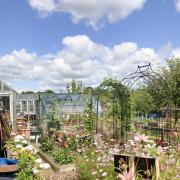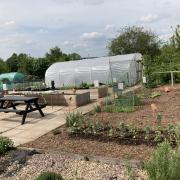Time to get plotting…
It seemed like a good idea at the time. Turning a disused corner of our 9.5-acre city centre site at Ashbourne Road and District Allotments into small plots which could be used on an annual basis for ‘Starters’ - people who wanted to learn about allotmenting without committing to a full-sized plot.
An area of learning where mistakes could be made and support would be offered for those who wanted to ‘try’ to grow their but who had no idea how to.
Through months of wallowing in mud, shovelling stones and clearing years’ worth of thick brambles and rubbish, the hard slog eventually paid off.
As volunteers grappled with the weather and all that goes with winter projects, in May 2019 the newly created, manicured six small plots (each measuring 3m x 7m) were levelled, dug over, fenced off and each allocated their own tool shed containing essential tools. A perfect learning space. Not a weed in sight and literally all were ‘good to grow’.
Since then, there has been a steady stream of new Starter plot holders eager to fit their (usually) fairytale ideals into their allocated spaces, keen to learn the basics and attend the weekly training sessions delivered from the Growing Academy - a community poly tunnel turned into a classroom arena to teach the basics of growing from seed through to planting on the plots.
After 12 months on the Starter plots, the plot holders graduate to the main site and a full-sized plot or, as some have done, decide not to continue, having experienced reality gardening which is very different to telly gardening programmes!
Gill Black was one of the first set of Starters back in May 2019. She is now a fully-fledged plot holder on plot 86 of the main site.
‘I loved it on the Starters! People helped each other, shared knowledge (as well as spare plants), and it was the best time to learn for me,’ she says.
‘We all need help at times in our lives and thank goodness someone came up with the idea of Starter Plots. Sheer genius.’ (Well. We weren’t not going to publish that paragraph, were we?).
Over the years, half the Starters have moved to plots on the main site and continue to make great progress unsupported.
Others try this lifestyle to learn slowly about the hard work involved – such as the hours of relentless weeding and the never ending watching of the weather.
Most admit they have had a lovely year on site, successfully growing their own crops and enjoying being part of the allotment community.
But what lessons has our association learned? This model has so far worked well on our site. Nothing beats hands on supported learning, which has continued to be an overall success every year since the original investment those years ago.
Some things go unnoticed, like the growing of new friends, new tastes and experiences, but remember what Megham Trainor sang, ‘It’s all about the veg’, or something similar…

Scent of summer
Physically we can’t smell seasons, but the fragrance from the blooms of sweet peas is definitely the ‘scent of summer’.
A vase of the long-stemmed pretty flowers fills any room with that distinct, heady sweetness and, although once picked they only last a matter of days, we feel they are definitely worth growing for that few minutes of intoxicating wonder!
Our experience is that all sweet peas (both annual and perennial) love their ‘faces in the sunshine and feet in the shade’.
They are very well suited for growing in large containers where watering can be directed at the roots of these thirsty, hungry plants. They grow well in the ground too in rows, supported by nets, bamboo canes or knobbly, thin branches.
In prepared containers of horse muck (obviously) and garden soil, the plants are guaranteed a constant feed and able to retain the moisture they need for speedy growth but again, they require support around the perimeter of the pots.
Watering regularly keeps the roots damp. If the plants dry out, there is no ‘recovery remedy’ and the sweet peas will go quickly to seed. But hey, if that does happen - all is not lost!
Every year when our plants finally do go to seed, we grab our old paper gift bags saved from Christmas and birthdays and drop all the plump, brown, dried seed pods into them; remembering to squash down the tops of the bags to keep the seeds to plant again next year.
Did you know that as sweet pea pods dry, they twist and release their seeds into any warm atmosphere dispersing them far and wide. We speak from experience. If you look carefully, you will find sweet pea seeds scattered in tiny crevasses in our sheds, hair and cars too!

Cucumber gin
Grown too many cucumbers? Try making cucumber gin to mix with cold sparkling tonic or even lemonade.
Ingredients: 4 small cucumbers or 3 long ones; Large bottle of cheap gin; Large sweet jar or kilner type jar.
What to do:
Peel the cucumbers and slice in half lengthways
Slide a spoon along the lengths to remove all seeds
Chop the cucumbers into inch pieces and place into sweet jar
Pour over gin, replace jar lid and shake!
Leave the cucumber in the gin for around a week
Sieve and strain to remove cucumber
Bottle and keep refrigerated.
Cheers!

Tomatoes
Is there anything to match the taste of a freshly picked tomato straight from the vine in the greenhouse on a summer’s day? Not in our eyes! Even the smell of the plant is something that takes us back to our childhoods.
We believe there is a tomato out there for everyone.
Elaine waxes lyrical about the ‘Red Robin’, a dwarf variety which takes no effort to grow and produces tiny red cherry fruits from the 12-inch plants.
In comparison, Julia’s preference is the whopping ‘Beefmaster’, a Mediterranean variety producing huge, slicing tomatoes on plants supported by scaffolding in the polytunnel.
Pass the salt!

The National Garden Scheme
Fancy a nice cuppa and a piece of homemade cake? Look no further than the National Garden Scheme (NGS), also amusingly recognised as the ‘National Nosey Scheme’ as it’s the opportunity to gawp at the contents of other people’s outdoor spaces.
Reasonably priced plants and knowledgeable gardeners eagerly await your visit.
Gardens around the whole county are open for viewings each weekend of the summer months including: Barlborough Gardens (£6) Repton NGS Village Gardens (£6) and Stanton in The Peak Gardens (£5) and all proceeds will support some of the best loved nursing and health charities!
(To find a garden; visit ngs.org.uk).



























